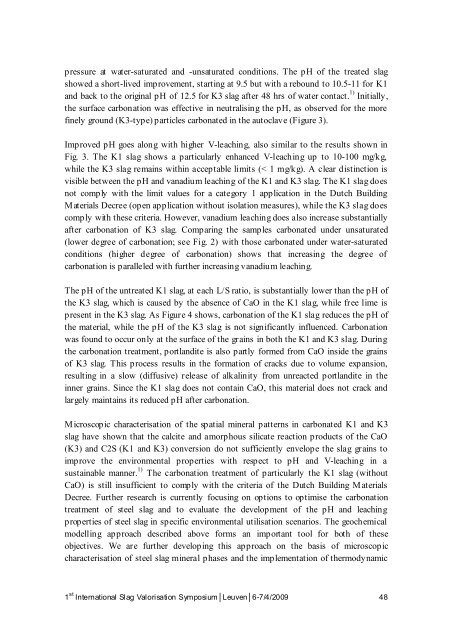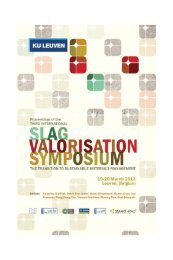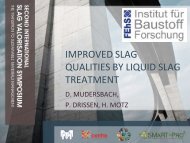International Slag Valorisation SymposiumLeuven6-7/4/2009 - Third ...
International Slag Valorisation SymposiumLeuven6-7/4/2009 - Third ...
International Slag Valorisation SymposiumLeuven6-7/4/2009 - Third ...
You also want an ePaper? Increase the reach of your titles
YUMPU automatically turns print PDFs into web optimized ePapers that Google loves.
pressure at water-saturated and -unsaturated conditions. The pH of the treated slag<br />
showed a short-lived improvement, starting at 9.5 but with a rebound to 10.5-11 for K1<br />
and back to the original pH of 12.5 for K3 slag after 48 hrs of water contact. 1) Initially,<br />
the surface carbonation was effective in neutralising the pH, as observed for the more<br />
finely ground (K3-type) particles carbonated in the autoclave (Figure 3).<br />
Improved pH goes along with higher V-leaching, also similar to the results shown in<br />
Fig. 3. The K1 slag shows a particularly enhanced V-leaching up to 10-100 mg/kg,<br />
while the K3 slag remains within acceptable limits (< 1 mg/kg). A clear distinction is<br />
visible between the pH and vanadium leaching of the K1 and K3 slag. The K1 slag does<br />
not comply with the limit values for a category 1 application in the Dutch Building<br />
Materials Decree (open application without isolation measures), while the K3 slag does<br />
comply with these criteria. However, vanadium leaching does also increase substantially<br />
after carbonation of K3 slag. Comparing the samples carbonated under unsaturated<br />
(lower degree of carbonation; see Fig. 2) with those carbonated under water-saturated<br />
conditions (higher degree of carbonation) shows that increasing the degree of<br />
carbonation is paralleled with further increasing vanadium leaching.<br />
The pH of the untreated K1 slag, at each L/S ratio, is substantially lower than the pH of<br />
the K3 slag, which is caused by the absence of CaO in the K1 slag, while free lime is<br />
present in the K3 slag. As Figure 4 shows, carbonation of the K1 slag reduces the pH of<br />
the material, while the pH of the K3 slag is not significantly influenced. Carbonation<br />
was found to occur only at the surface of the grains in both the K1 and K3 slag. During<br />
the carbonation treatment, portlandite is also partly formed from CaO inside the grains<br />
of K3 slag. This process results in the formation of cracks due to volume expansion,<br />
resulting in a slow (diffusive) release of alkalinity from unreacted portlandite in the<br />
inner grains. Since the K1 slag does not contain CaO, this material does not crack and<br />
largely maintains its reduced pH after carbonation.<br />
Microscopic characterisation of the spatial mineral patterns in carbonated K1 and K3<br />
slag have shown that the calcite and amorphous silicate reaction products of the CaO<br />
(K3) and C2S (K1 and K3) conversion do not sufficiently envelope the slag grains to<br />
improve the environmental properties with respect to pH and V-leaching in a<br />
sustainable manner. 1) The carbonation treatment of particularly the K1 slag (without<br />
CaO) is still insufficient to comply with the criteria of the Dutch Building Materials<br />
Decree. Further research is currently focusing on options to optimise the carbonation<br />
treatment of steel slag and to evaluate the development of the pH and leaching<br />
properties of steel slag in specific environmental utilisation scenarios. The geochemical<br />
modelling approach described above forms an important tool for both of these<br />
objectives. We are further developing this approach on the basis of microscopic<br />
characterisation of steel slag mineral phases and the implementation of thermodynamic<br />
1 st <strong>International</strong> <strong>Slag</strong> <strong>Valorisation</strong> Symposium│Leuven│6-7/4/<strong>2009</strong><br />
48







